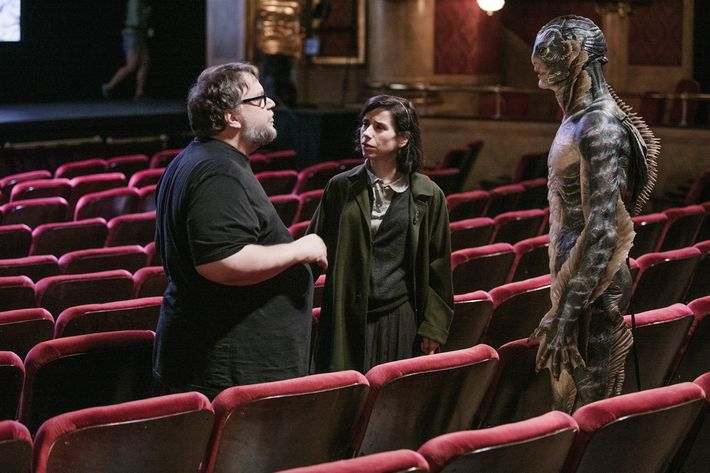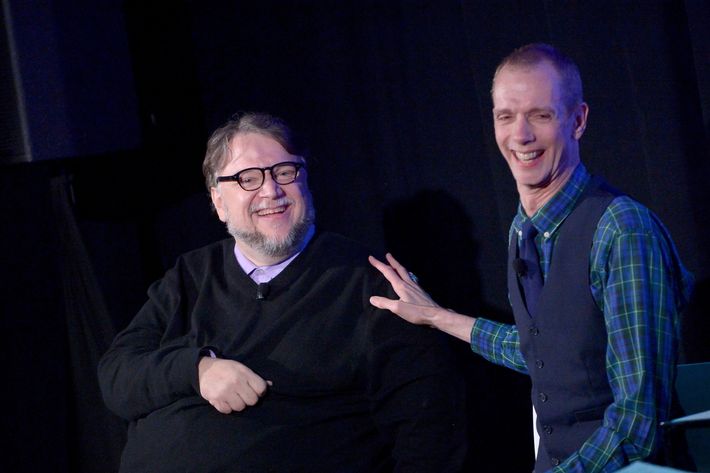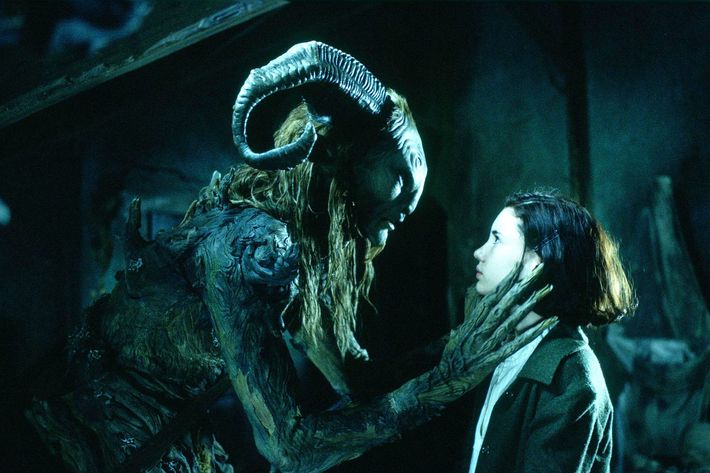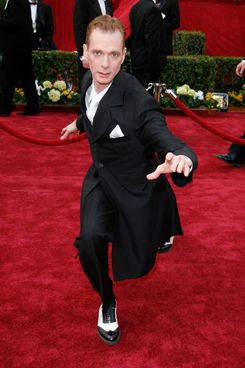Betty Grable had the legs. Paul Newman had the eyes. Doug Jones has the hands.
Unless you’re a hardcore fan of director Guillermo del Toro, you might have trouble placing the 57-year-old actor’s face, which is usually hidden behind all kinds of rubber and silicone. But you remember those long, expressive fingers — gesturing archly as Abe Sapien in the Hellboy movies, twisting with menace as the Faun in Pan’s Labyrinth, or searching for a child-shaped meal as the Pale Man in the same film. He is perhaps the only person in America who could beat Giannis Antetokounmpo in a thumb-wrestling contest.
The hands are just as striking in person. When you interview him, the actor is quick with a warm touch on the arm or shoulder, which is reassuring once you’ve gotten all thoughts of the Pale Man out of your head. But when it came time to film The Shape of Water, his sixth film with del Toro, Jones’s usual actorly tricks were forbidden. “Guillermo said, ‘I don’t want a flourishy Dougie Jones performance,’” he recalled. “There was none of that this time. This is a raw animal from the wild.”
In Water, Jones (who is neither an Alabama politician nor a Twin Peaks character) gets his highest-profile film role yet. He plays a fish-man being kept in a secret government lab in early ’60s Baltimore, who meets and falls in love with a mute cleaning woman played by Sally Hawkins. Though the role only required around two hours a day sitting for makeup — some scenes in Hellboy took seven — the physical rigors were immense. The creature suit was so tight it required three people to help shimmy him into it. In certain shots, Jones had to act while completely blind, thanks to the fish-man’s painted eyes. As he told the crowd during a recent appearance with del Toro at Vulture Festival Los Angeles, each shooting day was a feat of endurance, in more ways than one: “I couldn’t poop. It would’ve ruined the suit to have a trap door built in.”
Besides the technical aspects of the role, Jones was also faced with a particular creative challenge: He had to be both inhuman and feral, but also sexy. An actor’s first instinct is to listen, but that was the one thing he couldn’t do. “When Sally’s speaking sign language, I fought the urge to nod, like ‘I get you.’ Those are human gestures,” he said. “I had to think more like a dog. Your dog doesn’t know how to nod like a human. He might tilt his head and go, ‘Huh?’ Or he’ll put his ears down like, ‘Enough of that, feed me.’”

As for the sexiness, del Toro told Jones to lead with his hips, like a matador. The creature design helped, too. “They sculpted me a beautiful body,” Jones said. “That is the best ass I’ve ever had.”
When Jones was walking the Shape of Water red carpet in Toronto, reporter Josh Rachlis handed him a Sharpie sketch of the actor alongside his fish-man character. “Is there any monster you feared, but then you came to realize was okay?” Rachlis asked. Jones had a surprising answer: His monster, he said, was himself.
“It took me until my 40s before I could fully embrace this tall, skinny, gangly person that I am,” he told Vulture. “God created me just as I am for a very specific purpose, and I think that’s true for all of us.”
Jones grew up in Indiana, the youngest boy in a family of midwestern Catholics. “As a youngster, growing up in the Midwest and looking different than the normal kids is kind of a curse,” he told Vulture. “I was the butt of many jokes. I had to develop a sense of humor as a defense mechanism. If they were gonna laugh at me, I was going to control when and why it happened. In a way, I developed my sense of humor out of fear.”
His entry into show business came when he was recruited into the mime troupe Mime Over Matter at Ball State University. “They saw how I was kind of a goofy soul,” he said. “I’m six-three-and-a-half and I weigh 140 pounds, so that lends itself very well to miming.” He was mesmerized by the practice, and after graduation, he took his talents to Cincinnati’s Kings Island theme park, working as a street mime. “Street mimes are the ones that give mime a bad rap,” he said. “They’re the ones who follow you around, mimic you, play with your hat.” That made the park’s patrons, and him, uncomfortable, so Jones developed a less confrontational routine. “I was a tasteful, classy mime. That’s what I wanted to be, not a getting-in-your-face mime.”
Eventually, Los Angeles beckoned. Like Sebastian in La La Land, Jones had a very specific Hollywood dream. He’d always been more inspired by goofy sidekicks like Danny Kaye and Barney Fife than the handsome heroes, and he figured he’d be able to make a living being that guy in a sitcom — “come in, do an armpit fart, and then leave.” But the business had other plans. “Little did I know that going to L.A. and having ‘mime’ on your resume, that was an agent’s dream for commercials,” he said. At the end of his second commercial class, the teacher pulled Jones aside and gave the actor his card. He turned out to be the head of the commercial department at Wilhelmina. “I fell into great hands,” Jones said. In the fourth job he ever booked, he played a cool-cat crescent moon who sat behind a piano, extolling the wonders of McDonalds. If you were not alive in the late ’80s, it might be hard to fathom how much this gig changed his life.
The “Mac Tonight” campaign ran for three years, all over the world. Jones filmed 27 spots in all, earning enough money to buy his first house. More importantly, he said, the ads got him a reputation as a guy who could move like a dancer while wearing “a lot of crap of his head,” and would never, ever complain.
Spending hours in the makeup chair can be incredibly stressful for actors — Jim Carrey was in such a bad mood on the set of How the Grinch Stole Christmas that he sent his makeup artist into therapy — but Jones seems to take pride in being able to cope with hours sitting, standing, or squatting in the chair. “I don’t go stir-crazy,” he said. ”I’m a lazy person in real life, so if you give me a chance to sit still with nothing expected of me, great.” It helped, too, that for much of his life he was an inveterate people pleaser. “I wanted everybody to like me. When I would walk into a room, if I didn’t win everybody over it was an unsuccessful event.”
Like any small industry, Hollywood creature shops run on word of mouth, and in the early ’90s Jones found himself one of the most in-demand monsters in town. He was a freaky clown in Batman Returns, a zombie in Hocus Pocus, and giant kangaroos in both Tank Girl and Warriors of Virtue. He was happy enough, but inside, he feared getting stuck behind a mask for the rest of his career. Then in 1997, he took what turned out to be his most fateful gig, playing a shapeshifting cockroach for reshoots on Mimic, del Toro’s English-language debut. It was an instant connection.
“He’s an 8-year-old boy tucked into a roly-poly man’s body. He loves creepy monsters and wants to talk about them,” Jones said of the director. In Jones, del Toro found perhaps the only person in Hollywood who knew as much about movie monsters as he did. “He was like, ‘What have you done before?’ He was so excited to talk about the makeup artists I’d worked with. ‘Yes, Tony Gardner, he made a beautiful zombie. Whoever you are, I love you.’”
The next time they talked was five years later. Del Toro was planning his adaptation of the Hellboy comics, and he needed someone to play his favorite character: the erudite, egg-loving amphibian Abe Sapien. His team pointed out that the sketches for the character looked like that actor Doug Jones, and voilà, the former cockroach got the job. “That’s the one that synced us as an actor-director team that really understood each other,” Jones recalled. From then on, he would appear in every del Toro film but Pacific Rim.

Besides their shared love of monsters, Jones’s unique frame presents almost a blank slate for the filmmaker. “Doug was blessed with no shoulders and no ass, so we can do whatever we want,” del Toro said at Vulture Fest. “He is like a wire armature with a sense of humor.” Still, even he admits it took him a while to see Jones as something more than a body in a suit. “As we age, I get more empathic with Doug,” he said. “When we were both young, I didn’t care. ‘Let him suffer for his check!’” Only later did he realize the depths of Jones’s commitment.
“On Hellboy 2, when he performed the Angel of Death, we created these incredible mechanical wings,” he recalled. “They weighed as much as a Vespa, and they dug into Doug. I said, ‘Doug, how are you feeling?’ ‘Well, I’m bleeding, but otherwise I’m okay.’ We removed the wings, and the next day we assisted him with a wire, but again, I would see Doug just quietly bleeding. I think he’s some kind of samurai. He has that discipline for the craft.”
Though Jones spent hours in the Abe Sapien suit in the first Hellboy film, that’s not his voice you hear in the film; that job was given to David Hyde Pierce. Later, when Jones filmed the Fantastic 4 sequel, the same thing happened; he played the Silver Surfer, but Laurence Fishburne did the voice. He knew that’s how the business went sometimes — he wasn’t a name, Pierce and Fishburne were — but it still stung. “No actor wants that to happen,” he said. “That’s like a painter finishing a beautiful piece of artwork and having somebody come in and touch it up without his knowledge.” Privately, del Toro was apologetic about the slight, and swore to make it up to him. And he did — Jones voiced Abe Sapien in the sequel, the video game, and the animated TV movies. A few years later, the director gave Jones an even greater gift.

Del Toro is constantly surrounded by swells of people; Jones calls him “the most sought-after man I’ve ever known.” It wasn’t until they were prepping Pan’s Labyrinth, a decade after they’d met, that the two men were ever alone together. Jones had been the director’s only choice to play the Faun, a magical trickster who, besides the usual issues of the costume, spoke entirely in Spanish. The actor was nervous he wouldn’t be able to pull it off, but over the course of a long, rambling lunch at del Toro’s house, his nerves were soothed. “We sat and talked about life and love and religion and all kinds of things,” he said. “He was fascinated with my Christianity. He has a sense of rebellion in him that comes out in his films. He still has quite a reverence for the Catholic Church, but he’s not going to adhere to all the rules. He was fascinated that I still do.” The movie would share this religious tension; del Toro’s friend Alejandro González Iñárritu has called it “a deeply Catholic film.”
Jones was the only non-native Spanish speaker on the Pan’s Labyrinth set. “He was so lovely and sweet,” Pan’s Labyrinth star Ivana Baquero told Vulture over email. “I was with my mom: She spoke no English and Doug spoke no Spanish, so I remember translating for both, and it was so adorable. He truly is a kind soul, and he never lost his warmth and generosity even after the long hours of work in the different creature prosthetics.”

Jones spent ages learning “an archaic form of Spanish” so he could understand his lines, but his voice was once again dubbed (this time by a natural Spanish speaker). Though this irked him, the language issue turned out to have an unexpected effect on his career. As the only American in the cast, he became the face of the film’s U.S. press tour. “I was 46 at the time. I thought my days of becoming a name were probably numbered, but that was the year that turned the page for me,” he said. Suddenly he was in the news, and it seemed like every interview included a rundown of his past roles. He was even invited to the Oscars, where Pan’s Labyrinth won three awards. No longer was he hidden behind a mask, and all that attention brought newfound respect for his kind of work. Now, he’s said, “I could retire with rubber on my face.”
This higher profile was accompanied by a new self-confidence. “In my 40s I was able to trust my own voice,” he said. “I don’t need to please everybody around me all the time, and that’s okay.” Jones is at the point in his career when he no longer has to audition, and for his recent role on Star Trek: Discovery, he had the most input on the creature-design process he’s ever enjoyed, urging the filmmakers to make his character’s fingers shorter (in case he ever needed to hold anything) and scrap his false teeth (to save money on ADR). “They took those to heart right away,” he said, smiling.
Jones may have played the title character in Pan’s Labyrinth, but The Shape of Water is the first del Toro film in which he’s one of the leads. The director pitched it to him on the set of 2015’s Crimson Peak; it was the second — and so far, the last — time the two were ever alone together. As del Toro explained, his next film would be a monster movie with a romance, and he wanted Jones to be the monster. But this time, he was the one who was worried: Would Jones, a “good Catholic boy,” object to the bestiality? Five movies into their collaboration, Jones had the unique experience of assuring his friend that playing a magical fish-man who has sex with a human woman would not violate his religious beliefs. “I don’t know that even the Bible addresses what a fish-man can do,” he says. “Does he have to get married first? I don’t think so. Animals in the wild just kind of do it.”
Many of del Toro’s movies act as maps of his own influences. It may be a coincidence, but The Shape of Water is the first one where you can see a little bit of Jones in there, too. Since neither the fish-man nor Hawkins can talk, the whole romance plays out through mime. “You realize when your words are taken away how much communication we still have,” he said. “How we emote and connect through gestures, through a glance, through a touch.” Jones grew up a huge fan of Fred Astaire; at one point, he and Hawkins take part in an elaborate musical number. (He credits the weeks of dance rehearsals for their onscreen chemistry.) He even got to do the character’s inhuman squawks himself. “Guillermo wanted me to do an outward growl,” he said. “I didn’t think a fish-man would growl, so I did more of an inhale, like a fish gasping for air. More of a Hup! Hup!”
As for the sex, Jones demurred. “I was quite curious because that was a new one for us,” he said. “But it is tasteful and it is beautiful. I know the sexiness has been honed in on in the press a little bit. But it’s not a story about sex at all. It’s a story about love and finding it in unforeseen places. To find ourselves vulnerable and naked in front of each other was part of the beautiful tale that Guillermo was telling.”
The Shape of Water is widely predicted to be one of this year’s major Oscar contenders, and though the Academy has not yet created a category for Best Actor in a Monster Suit, Jones may get one more chance to walk that red carpet in support of the film. If he does, he’ll be doing it as a man who’s comfortable in both his amphibian and human skin. As he puts it, “That monster has been tamed.”
Additional reporting by Scott Huver.



